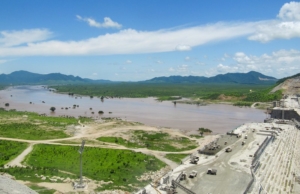The Grand Ethiopian Renaissance Dam and Its Effect on Egypt
 The Grand Ethiopian Renaissance Dam (GERD) will allow over 65 million Ethiopians access to electricity. Many estimate it to cost as high as $5 billion. Using two large turbines, the dam will bring more than 6,450MW worth of power to the country.
The Grand Ethiopian Renaissance Dam (GERD) will allow over 65 million Ethiopians access to electricity. Many estimate it to cost as high as $5 billion. Using two large turbines, the dam will bring more than 6,450MW worth of power to the country.
Project Background
Construction of the Grand Ethiopian Renaissance Dam began in April of 2011 and finished in July of 2020. The dam can hold up to 74 billion cubic meters of water, which makes it the largest hydropower project in Africa.
Located in the Benishangul-Gumuz Region, about 30 km upstream from Sudan, the U.S. Bureau of Reclamation identified the site between 1956 and 1964. But, construction only actually began after surveys in 2009 and 2010.
Funds from local taxes, donations and government bonds raised the necessary $4.8 billion to cover construction costs. Ethiopian’s at home and abroad provided the first $350 million. Then, the state-owned Ethiopian Electric Power Corporation invested some of its own revenue, as well as money borrowed from state-owned banks.
Controversy
Despite the benefits some say the dam will have, the project is not without controversy. Over the last decade, the governments of Ethiopia, Egypt, and Sudan are working to come to an official agreement on how the GERD will operate.
The Egyptian government voiced strong opposition to the GERD stating that it will cause major disruptions to the Nile. Egypt depends on more than 90% of its water from the river. Egyptian Foreign Minister Sameh Shoukry said that Egypt is facing “an existential threat” because of this project.
For Egypt, the main concern lies in the impact on the water supply of previous dams on the Nile. They worry GERD will do the same. The annual flooding of the Nile is one of the most important natural events that occur throughout Egypt’s history. Egypt relies heavily on this annual event for its agriculture. Additionally, there is concern that the GERD could alter this flooding and/or interfere with the flow of sediments that are vital for growing food in the region.
Furthermore, the Sudanese government expressed concern over the effect of the dam on its people and their water rights. In June 2021, Sudan and Egypt released a joint statement. They urged for a legally binding agreement between the countries before Ethiopia began its second filling of the dam.
Water Rights
The Nile Waters Agreements of 1929 and 1959 gave Egypt and Sudan the right to all the water in the Nile. These agreements also gave Egypt the right to veto any upstream construction, such as the GERD. However, The agreements did not include Ethiopia. Therefore, Ethiopia does not recognize the agreements as legitimate.
Since Ethiopia does not recognize the Nile Waters agreements, Egypt and Sudan pushed to get a legally binding agreement. The new agreement would place restrictions on the amount of water Ethiopia may hold in the dam. However, Ethiopia refused to agree to any of these restrictions, instead favoring looser guidelines that are not legally binding.
However, the international community supports Egypt’s calls for a formal agreement. The United States warns that filling the dam without an agreement in place would lead to heightened tensions in the region. In July 2021, the United Nations Security Council made another attempt at mediating the conflict, the latest in the decade-long struggle to reach an agreement. These talks also failed and Ethiopia proceeded to fill the dam.
Looking Ahead
Despite the controversy and the Grand Ethiopian Renaissance Dam’s effect on Egypt and Sudan, it appears that the Ethiopian government will continue to move forward with filling the dam. In July of 2021, the second filling of the dam was completed. Even with the controversy, the project will provide electricity to millions in the region who previously did not have access. This is sure to have a positive impact on the citizens of the region.
– Taryn Steckler-Houle
Photo: Flickr
